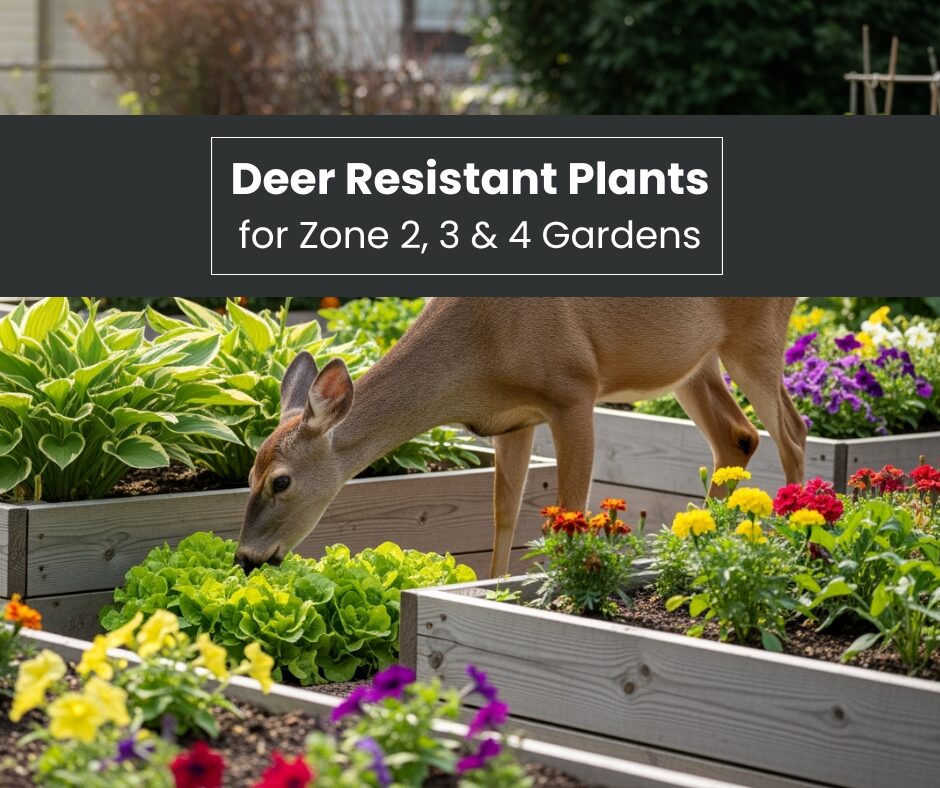Quiet? Yes. Cute? Sure. Harmless? Not if you have a garden. As urban and suburban development encroaches on deer habitat, it’s increasingly common to see deer wandering into yards throughout Western Canada – even if you live “in town.” They browse along habitual routes daily, treating your yard like an all-you-can-eat buffet. Gardeners who wake up to neatly pruned roses or completely vanished tulips know just how frustrating these unwelcome visitors can be.
If their preferred foods are scarce, deer will sample almost anything to survive. No plant is truly safe from these hungry nomads, and gardeners must assume that a sufficiently hungry deer will sample even supposedly “resistant” plants. So… can they be stopped? And How?

Plants Deer Don't Like (Deer-Resistant Plants)
Ok so there is no such thing as a truly deer-proof plant… but one of the smartest preventive measures is to plant things deer are a lot less likely to eat. While no plant is guaranteed safe, deer tend to avoid plants with certain characteristics:
- Strong odors. Deer have an extremely sensitive sense of smell, which they heavily rely on, to detect predators and locate food. Strong-scented plants interfere with this critical survival mechanism. When deer encounter plants with pungent odors (like garlic, lavender, or mint), the overwhelming scent masks their ability to smell approaching danger. This makes them feel vulnerable and unsafe, so they instinctively avoid these areas.
- Fuzzy or prickly foliage. Deer prefer tender, easy-to-chew vegetation. As you might imagine, fuzzy leaves (like lamb’s ear) and prickly textures are physically uncomfortable to eat (not to mention difficult to digest). Plainly put, it’s unpleasant. And it’s simply not worth the effort when softer options are available.
- Bitter or toxic compounds. This is just Darwinism at it’s finest. Deer have developed a natural aversion to bitter tastes because in nature, bitter often signals “poisonous.” In fact, plants usually produce these compounds as defense mechanisms (like alkaloids in poppies or toxic compounds in foxglove), to avoid being eaten!
- Tough, leathery leaves. Generally, these types of plants require a lot of energy to digest while providing relatively little nutritional value. Animals are all about efficiency – evolution has taught them to seek out maximum nutrition for minimal effort. Thick, leathery foliage (like some viburnums) is hard eat and doesn’t provide nutrient-rich food.
By filling your garden with these kinds of plants, you make your yard much less appetizing to passing deer. For some ideas, check out our list of “deer resistant plants” – plants that they generally find these unpalatable and will only eat if desperate (click the yellow button below).

Get Your Free Plant List
Download our free Zone 2-4 Deer-Resistant Plant List for an easy place to start.
Plants Deer Love (Plants to Avoid)
While it’s useful to use deer-resistant plants in your garden, it’s also important to know which plants deer prefer, as these highly attractive varieties should be avoided or well-protected in deer-prone areas. Deer especially enjoy ornamentals like hostas and daylilies, often eating them down to stubs. To minimize deer problems, avoid planting large groups of these favorites. Some characteristics that deer find particularly appealing are:
- Soft, tender foliage. Deer are selective by nature, whenever they have the opportunity – they’re picky eaters who choose the easiest-to-digest, most nutritious parts of plants. Evolution has wired them to prefer tender new growth and soft shoots, which require minimal energy to eat, and are packed with sugars and nutrients. Deer especially love new plant growth, because plants send lots of carbohydrates and sugars into those particular tissues, to satisfy the intense energy requirements of “growing!”
- High water content. Plants with high moisture content are like a two-for-one deal for deer – they get hydration AND nutrition in one bite. This is especially appealing during dry periods or when natural water sources are limited. Succulent plants, like hostas, are prime targets.
- High nutritional value. Research shows deer actively select plant parts with the highest nutritional content, especially those rich in protein (think legumes like clover and alfalfa). They’re essentially foraging for the most nutrient-dense foods available – always seeking maximum bang for their ‘buck.’
- Sweet. Deer absolutely have a sweet tooth! Much like their preference for “new growth,” they prefer sweet fruits, berries, and high-energy foods like acorns. Sweet = quick energy, which is exactly what they need for survival.
- Availability. Deer are opportunistic – they go for what’s readily available and abundant. If your garden happens to be the most accessible, nutrient-rich buffet in the neighborhood, you’re going to be their first stop.
How to Protect Susceptible Plants
If you do grow any of the above in a deer-prone area, you may be able to protect them by using some simple strategies. Here’s a quick list of ideas:
- Place “deer favourites” closer to the house, or in a fenced area.
- Use more deer-resistant plants on the yard perimeter. For example, you might surround a rose or hosta bed with hardy, deer-resistant plants like ornamental junipers or spirea to create a dense, aromatic barrier—deer dislike both the scent and the visual obstruction.
- Never deliberately feed deer or leave out kitchen scraps – it only teaches them that your property is a feeding ground and encourages them to remain in the area.
- Keep your yard clean (mow tall grass where deer might bed down and clean up fallen fruit like apples or acorns) will make your garden less inviting to wandering deer.
- Use repellent sprays, motion-activated or sound-based deterrents to distract or deter deer away from plants they love.
In most cases, it’s not hard to keep a Zone 2, 3 or 4 garden safe from deer, but it does require some forethought and planning. Use our helpful list of Deer Resistant Plants (and Plants to Avoid) to design your garden wisely!

Get Your Free Plant List
Download our free Zone 2-4 Deer-Resistant Plant List for an easy place to start.
